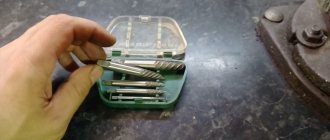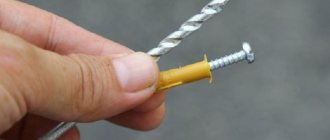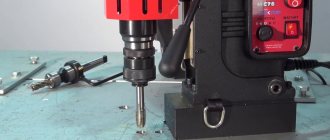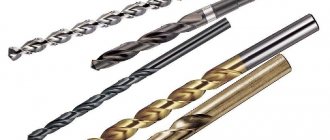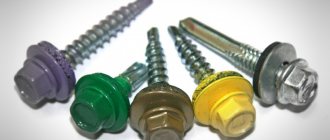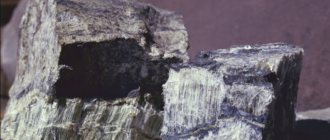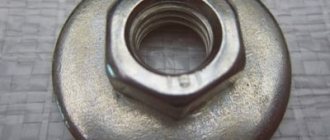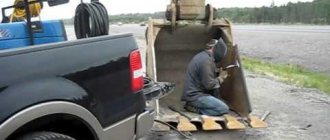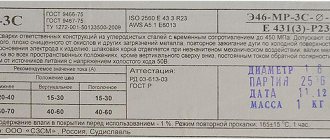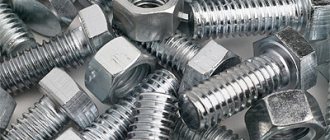Operating principle of the extractor
It is not difficult to use a reversal device if you first understand the intricacies of its operation. The problem of a broken screw is solved by the following steps: first, a small hole is drilled in the center of the fragment, which is smaller in diameter than the diameter of the body of the fragment. The extractor is inserted there, screwed into the fastener and unscrewed together with it.
Useful recommendations from experts on how to unscrew a broken bolt
If an attempt to unscrew a threaded connection is unsuccessful, then there are some useful tips and recommendations from experts that will definitely be useful to anyone who is faced with such an unpleasant situation. These tips are as follows:
- To increase the efficiency of the actions carried out, it is necessary to heat the threaded connection
- Using a hammer and a punch set at a 45 degree angle will help remove the remaining part of the broken bolt.
- It is necessary to use lubricants, including WD-40 lubricant, to remove corrosion
Experts also recommend purchasing a set of extractors. They are sold in quantities of 4 or more nozzles of different sizes. Having the appropriate attachments available, you can always quickly remove the deformed part of the bolt. The video below shows why you should buy only high-quality extractors and avoid low-quality and cheap devices.
https://youtube.com/watch?v=x51BqCC7eEI%3F
Publications on the topic
Wood hacksaws for the home, their types and requirements for selection
Types of wood planes and how to use the tool correctly
The device of pliers: types of pliers, their purpose and application
How to use a foam gun - device, types, selection and repair
Step-by-step instructions for removing debris
When unscrewing a broken fastener, it is recommended to follow simple rules:
- Before removal, the jammed bolt fragment is coated with a lubricant.
- Old or rusty debris is treated with a product that dissolves rust.
- A hole is drilled at the end of the bolt leg, centering the drill with the guide sleeve included in the kit.
- The rod is driven or screwed into the hole.
- After reliable jamming, the extractor is unscrewed along with the old part. This is done with a wrench or an adjustable wrench.
Overview of species
Depending on the type of tip, broken bolt extractors are designed for different types of work. External - the tail element most often has the shape of a hexagon or cylinder. For damaged hardware of different types, you need to select your own tool options.
Wedge-shaped
Products of this type have the shape of a faceted cone in the area of the working surface. In broken or torn hardware, it is installed with preliminary preparation of the hole, simply driving it into the thickness of the metal. Once the desired coupling level is reached, it is turned out using a wrench.
When working with wedge-shaped extractors, it is very important to correctly center the hole being formed, otherwise there is a high risk of simply breaking the tool. It will still be impossible to unscrew a damaged bolt if the axis of rotation is displaced
Rod
Quite an easy-to-use type of tool. Its design includes a rod that drives in and wedges a stuck bolt. Such extractors lend themselves well to rotation with a wrench after being jammed in the hardware. The problem arises later: it can be difficult to remove a tool from a metal product after work. Rod extractors have a noticeably shorter working part. The straight edges here are complemented by slots located perpendicularly. Externally, the tool is similar to a tap, which is used to cut threads on metal nuts and bushings.
Screw spiral
The most effective solution that allows you to easily unscrew almost any bolt, regardless of the complexity of their breakage. These extractors have a cone-shaped tip with a pre-applied left or right-hand thread. Their distinctive feature is that they are screwed in, rather than driven into the bolt when installing the connection. When working with the tool, you do not use a wrench, but a hand crank. This is something to consider: when purchasing sets, it is usually included in the package. Otherwise, you have to purchase an additional device separately.
Classification and design
To unscrew old bolts and studs with broken heads, you can use one of three types of extractor.
Wedge-shaped rod - has the shape of a faceted cone. It is hammered into the prepared hole in the end, wedged and unscrewed. The wedge extractor is easy to use, but requires precision in drilling the center hole to extract effectively. Once completed, it can be difficult to remove the extracted part from the turnout.
Benefits of using the tool
Unlike futile attempts to unscrew a wedged broken part by hand, using an extractor has several undeniable advantages.
- The tool is very easy to use. To use it, you do not need to have any special repair skills.
- Extractor kits are affordable, so everyone can afford them.
- The kit includes all available extractors of various sizes and diameters.
- When using this tool, you can very quickly unscrew any broken fastener stuck in an object, furniture, equipment or car.
- If you purchase high-quality tools made of durable steel, the likelihood of the extractor breaking during the process of unscrewing a stuck part will be minimized.
Of course, you need to take into account that not every bolt can be pulled out using this tool. The main rule to follow is that the body of the stuck part must be an order of magnitude softer than the material from which the tool is made. Therefore, it is best to purchase a high-quality set in a specialized store.
Extractor kits
For convenience and insurance for any unforeseen event, experts recommend buying a set with extractors. It has all the tools you need to easily remove a broken and stuck bolt.
Sets include tools of different diameters:
- bushings for removing the extractor using a wrench;
- bushings for centering the drill;
- drill;
- extractors.
Such kits are considered universal and convenient. But if you wish, you can purchase the tool separately.
Methods for removing broken bolts using an extractor
There are three possible types of failure: flush, internal and external, when the upper part of the damaged part is higher. The area where you need to drill a hole is never level. It's difficult to work on. The drill goes away.
Even with the help of an additional bushing, this operation is not easy. It's easiest when the bolt protrudes from the structure. You need to use a grinder and a file to level the surface. Mark the center of the hole and start working.
When performing the operation, you need to accurately drill and drive in the device to ensure alignment of the direction. This ensures the strength of the connection. Screw devices tend to be correctly oriented. You need to start screwing in the extractor effortlessly.
When the approach is made, the load is increased. After jamming, continue unscrewing the part. If rotation is difficult, then you need to make a movement in the opposite direction, and then continue extraction again. Otherwise, there is a risk of breaking the instrument.
Basic Debris Removal Methods
During normal unscrewing of a bolt, different situations occur. The head may break off below the surface level, or above. The location of the break affects how to unscrew the broken bolt without much effort.
The list of standard manipulations looks like this:
- The fragment is coated with lubricant or rust solvent if the part is old.
- Select the diameter of the extractor, and, based on its size, drill a hole in the center of the screw body (to accurately determine the center point, use the guide sleeve included in the kit).
- Screw or drive in the tool and jam it firmly.
- The fixed extractor is unscrewed together with the stuck hardware using a key or wrench.
Purpose and principle of operation of the extractor
Sometimes it happens that the screw fastening is damaged for various reasons, and without special tools it is not possible to unscrew the fastener.
The fastening rod itself may break or its head may fall off; also, the edges of the head slot are often licked off, so that there is nothing to catch on; in such cases, specially designed extractors are used to dismantle the screw fasteners.
This tool is indispensable for removing broken bolts from the landing site, for example, car mechanics use it to unscrew studs from the cylinder block, fasteners from the cylinder head, from the camshaft bed, from the exhaust manifold, to unscrew damaged or stuck wheel bolts from the hub and others similar cases.
Extractors can also be used to remove self-tapping screws, screws and dowel nails when the slots of their heads are licked.
With the help of small-sized extractors, it is very convenient to disassemble folding knives and other structural devices that use screw fastenings.
The screw connection can be damaged in the most unexpected situation, and then the broken fastener can be quickly and effortlessly removed without damaging the seat only using an extractor.
Each type of this tool has its own specific operating principle, which will be most suitable and effective in certain cases.
Operating principle of a wedge extractor
You need to drill a small hole of sufficient depth in the center of the broken bolt or stud, and then drive a screwdriver wedge into it.
Due to the corners of the tool, a tight engagement occurs, thanks to which it becomes possible to unscrew the broken fastener rod.
Next, using regular open-end wrenches or special tap holders, grab the shank of the screwdriver and unscrew the damaged hardware.
Operating principle of internal thread extractor
Partially similar to the previous version.
Here, too, in the center of the rod of the broken fastener, a hole is drilled into which a screwdriver is screwed, usually with a left-hand thread; accordingly, we turn the tool counterclockwise.
Due to the fact that the unscrew thread is cone-shaped, it fits tightly into the drilled hole and jams in it.
Important!
To prevent idle scrolling, it is necessary to apply sufficient force to press the tool tightly against the hardware being removed for reliable adhesion.
Thus, the extractor firmly engages with the body of the broken fastener, and with further turns it unscrews along its thread.
Such a screw extractor can be useful in the most unpredictable situations where screw fastenings are used.
Operating principle of external extractors
It differs in that it is used only in cases where the damaged fastener is of sufficient diameter and protrudes from the base.
Most often, external screwdrivers are used when there is a bolt head, but its edges are licked and there is nothing to grab onto with a regular wrench.
The process of fixing a bolt with licked head edges takes place from the outside; for this purpose, an extractor of the required size is selected and hammered onto the bolt head.
There are sharp edges inside the outer extractor that dig into the material of the licked bolt head.
Thus, engagement occurs, after which the damaged fastener is turned out.
External extractors are mainly used for unscrewing bolts whose heads have licked off edges and in similar situations.
You can also use an external extractor to unscrew nuts with damaged edges, but only if it is possible to attach a screwdriver to the nut.
Important!
To work with extractors, it is advisable to use a special wrench or a regular open-end wrench, but not pliers.
Effective ways to unscrew broken fasteners
Now let's look at how to drill out a broken bolt without special rods. A broken pin or bolt can be unscrewed without the help of extractors, but it all depends on the situation. If the breakage has already occurred at the exit from the thread, and part of the body of the fastener protrudes above the surface, then you can try to tighten it with pliers, a wrench or other tools.
There are several effective ways to remove a broken part. First you need to complete several preparatory steps:
- clean the work surface from debris and dirt;
- treat the threads with machine oil or anti-rust agent. You can relieve internal stress by hitting the piece with a hammer or heating it with a soldering iron, if possible.
If a break has formed above the threaded surface, then it makes sense to try two extraction methods:
- Pliers and an adjustable wrench will help remove the body of the bolt, provided that the threads are loose and movable.
- A grinder and a metal saw are used to form a transverse cut at the end of the hardware. A screwdriver is inserted into this hole and the element is unscrewed.
- The third method is the most labor-intensive, but just as effective. You will need a welding machine. A bolt with a head of approximately the same diameter is selected for the broken part. It is welded to the fragment by welding and the old fasteners are unscrewed without any extra effort.
Device and characteristics
Mechanical extractors can be internal, in terms of design: one-sided or double-sided, and external, in the sense of external.
All internal extractors are oblong in shape, with one or two working ends.
Single-sided screwdrivers have one working area in the form of a wedge or with a cone-shaped thread, left or right, with a short pitch, and on the other side there is a shank, which can be square or hexagonal.
There are also single-sided extractors, on the back of which there may be a head with a square or hexagonal throat.
For double-sided extractors, both ends are working, one of them is a short drill designed for drilling a hole of the required diameter, the other has a left-hand thread in the form of a cone, when there is a narrowing from the base of the tool body to its end.
Double-sided extractors are usually small in size, and are very similar to screwdriver bits.
Some kits come with external extractor guides designed for precise alignment so as not to accidentally drill into the main body of the object into which a bolt, stud or other fastener is screwed.
External extractors are very similar in appearance to impact sockets for impact wrenches, but they are not the same thing.
Inside the external extractors there are sharp edges in the form of smooth curls, which are absent in the socket impact heads, this is the main difference.
NOTE:
Sometimes impact sockets for impact wrenches are used as extractors, but with such treatment they quickly become unusable.
Material
Extractors are a very specific tool, intended for use only in certain emergency cases, where the hardness and strength of the material plays a very important role.
For the manufacture of extractors, carbide metals, carbon, high-speed steel are used, as a rule, these are types of hardened metal.
S2 tool steel, high-strength chrome vanadium steel CrMo, oxidized steel and other alloys with similar properties are often used.
To produce high-quality extractors, hardened steel with high hardness is always used.
Attention!
Clandestine manufacturers use softer metals in their production, which are initially unsuitable for the manufacture of such tools.
Therefore, when purchasing extractors, you need to pay attention to the manufacturer, labeling and brand under which the tool is sold.
Dimensions and weight
The weight of the tool depends on the metal used in its manufacture, as well as on its type and size.
Dimensions of internal extractors:
Length: from 26mm to 150mm.
Diameters of the conical tip: from 1.5 mm to 26 mm.
Weight: from 8 to 150 g.
For example, examples for screwdrivers, as a rule, are smaller in size and the weight of such a tool is also light.
Dimensions of external extractors:
Length: from 40mm to 80mm.
Working diameter: from 16mm to 26mm.
Weight: approximately 100-150g.
The dimensions of the external extractors correspond to the dimensions of the impact sockets (in inches):
- ¼
- 3/8
- ½
- ¾
- 1 inch
How to remove a broken spark plug
Spark plugs can also cause a lot of trouble; for some reason you were unable to unscrew the spark plug with a special wrench, and it broke. They break in the most vulnerable place, namely where the ceramic insulator and metal casing are connected to each other. There is nothing complicated here if you have an extractor and a torque wrench. Allow the engine to cool, then spray a small amount of WD-40 into the spark plug.
An extractor of a special diameter is inserted into the spark plug well. Once it is screwed in, you need to start the extraction process. This happens counterclockwise, since the candles are equipped with right-hand threads. All movements and actions should be unhurried, and the knob should be kept as level as possible. As soon as we have taken out the candle, we inspect the spark plug well for the integrity of the thread. It would be a good idea to blow it out of the compressor with compressed air.
With this we will say goodbye, dear readers. Don't forget to subscribe to blog updates if you haven't already. We expect many useful publications in the future. See you soon!
Design features and specifications of individual devices
In addition to the main types of extractors, there are other types of designs. What are they? On store shelves you can find the following products:
- Rod. An analogue of a cylindrical rod with longitudinal cutting edges. There are grooves between them. Drives into the center of the broken fastener. No pre-drilling required. The sharp edges fit tightly into the damaged hardware, which leads to reliable engagement. The other edge is equipped with a special nozzle with a tetrahedral shank, which is grasped with a wrench or wrench to deal with broken fasteners. According to buyers, the device is not very convenient, since it gets very stuck in the element being pulled out.
- Extractor – drill. The working end of the screwdriver resembles a left-handed drill. Faces – with cutting edges. It cuts into damaged screw fasteners on its own. After a tight jam, it is possible to remove the broken object.
- For a screwdriver. What to look for when choosing? The models are compact and are available in single-sided and double-sided versions. The body resembles a hexagonal rod. Can be used as a separate hand tool or as an attachment to a screwdriver. They are sold in sets that also contain guide bushings, knobs and drills.
- Combined. The set of characteristics of the rod and wedge-shaped analogues. The shape is wedge-shaped. The grip is excellent due to the presence of a large number of sharp edges. The device is driven into the center of the hardware being removed using a hammer. Once engaged, it can be twisted both to the right and to the left.
- Eccentric. The second name is a stud gun. Produced with an offset center. Area of use: unscrewing studs. The device is interesting. Allows you to unscrew a screw type fastener with a head with worn edges or without a head. Belongs to the category of specialized devices. The only limitation when using the device is that it will cope with the task if there is a place to grab onto. If the bolt body is completely embedded in the object, the eccentric product will be powerless to do anything.
- Secret extractor. The characteristics resemble an extractor in appearance - the best for extracting secret bolts from car wheels. A distinctive feature is the thickness of the walls. They are thinner so that they can be placed freely on the head of the wheel bolt without damaging the alloy wheels.
- Reinforced. A distinctive feature is the material of manufacture. The composition contains special additives that increase the strength index. This allows you to extend the life of the device and make it more reliable.
- For pipes. The main purpose is to remove pipe scraps, as well as various adapters in the sewer system. A conventional tool will not achieve the desired result. In appearance and operating principle it resembles a screw extractor, only the dimensions are significant. There is no need to drill a hole in the pipe. It is present initially and the device is screwed into it. After jamming, it is unscrewed together with the broken part of the pipe.
- Universal. With the function of extracting pipes or individual parts thereof, if it is not possible to get hold of it with another tool. Copes with all pipes, regardless of their diameter. The main thing is that the maximum size of the device itself is sufficient. Works in a similar way to an internal thread extractor. Suitable for other uses.
- Hydraulic. Belongs to the category of professional tools. The main purpose is to turn out rolled pipes. Belongs to the manual category. The dimensions are significant. Place of use: industrial production facilities.
How to choose the right product? It is necessary to decide on the scope of its use. This is the main selection criterion. Which product is better to buy depends on many factors, including the user’s personal preferences. You cannot make mistakes when choosing. Otherwise, a positive result will not be achieved.
The reliability and durability of the structure depends on the correct choice. It is worth noting that inexpensive devices made in the Middle Kingdom cannot be of high quality.
Where to buy devices? Experts advise visiting specialized retail outlets, getting acquainted with the presented assortment, holding the selected model in your hands, and determining the quality of the assembly and materials used. If necessary, you can get advice from a professional sales manager. You can order tools online in the online store. You need to treat such a purchase carefully, as there is a chance, instead of an expensive device from a leading foreign manufacturer, to become the happy owner of a disposable budget Chinese counterfeit with questionable performance characteristics.
